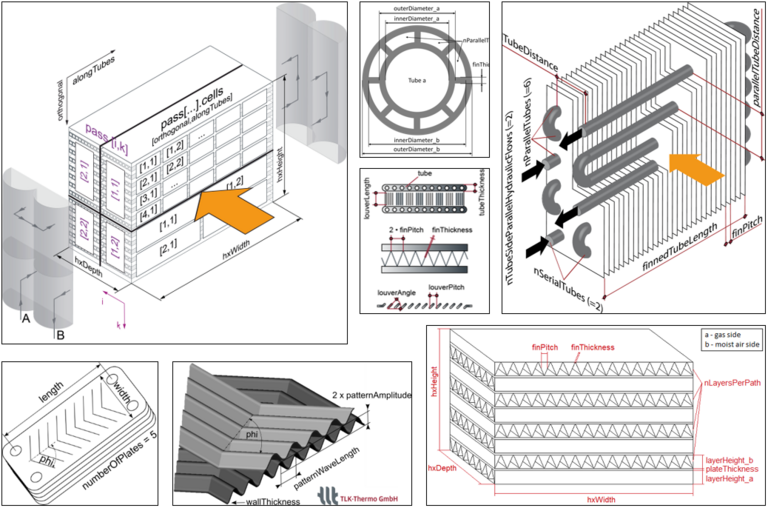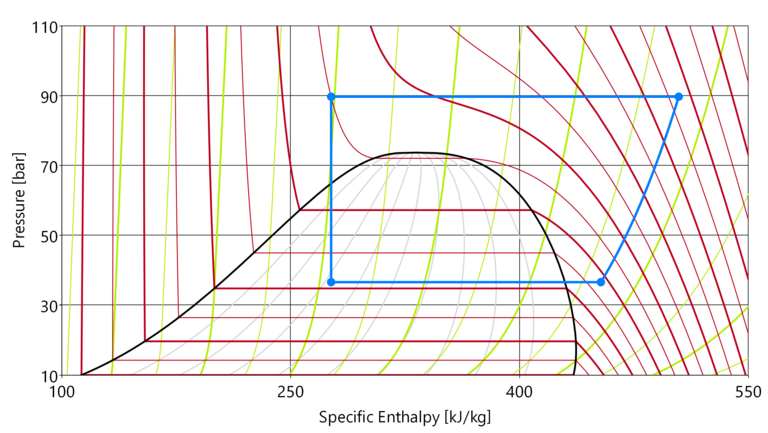TIL Suite
TIL Suite consists of the model library TIL and the substance data library TILMedia. With this software package we enable our customers to perform steady-state and transient simulations of thermodynamic components and systems. In addition, we offer many subject-specific components and systems in add-on libraries. The TIL models can either be used in Modelica simulators or exported for use in other simulators via code export or model exchange.
TIL Suite provides versatile component and system models. The components of this software package are the basic library TIL, the material data library TILMedia, and various add-on libraries. A faster and more robust HD (Highly Dynamic) version of TIL Suite is also offered. Our many years of experience from a wide variety of service and research projects in simulation, testing, and software development is also incorporated into TIL Suite.
Individual components can be mapped and calculated in detail with TIL. The included models are well suited to the design and optimization of large and multi-layered systems. In addition to high accuracy and simulation speed, TIL Suite is characterized above all by great flexibility and adaptability. Component models can be easily exchanged using the graphical user interface, interconnected to form testers or entire systems, and configured down to the last detail. The code of the model libraries contained in TIL Suite is mostly visible and based on an object-oriented structure. Model details and components can be viewed, copied, adapted, and extended.
TIL Suite can be used to model the following systems, among others:
TIL HD is a variant of TIL Suite that has been specially developed for highly dynamic simulations under transient boundary conditions. This includes, for example, systems in which switching processes with flow reversal take place or where entire sections are switched off. With TIL HD, such complex simulations can typically be performed faster and more robustly. TIL HD differs from TIL by the specially adapted energy and mass balances of components with volume or with differential state; however, it is very easy to switch between TIL and TIL HD at any time without having to modify existing system models.
In addition to the component and example system models already included in TIL, numerous add-on libraries are available. They contain models that are adapted to the respective subject area, thus enabling more extensive or detailed simulations. For the use of add-ons the basic TIL library or TIL HD is required.
For the following areas, licensable TIL Add-Ons are available on request:
- Add-On HydrogenEnergySystems:
Fuel cells, PEM, SOFC, electrolyzers, H2 refueling stations, H2 liquefaction - Add-On Automotive:
Passenger compartment air conditioning systems, driving cycles - Add-On Cabin:
Vehicle cabins (car, bus, train, truck) - Add-On PolynomialCompressors:
Compressors according to EN 12900 or AHRI 540 standards (10 coefficient polynomial compressor)
The TIL Add-On HydrogenEnergySystems can be used to model and simulate systems along the entire hydrogen value chain (production, storage and distribution, application).
H2 production:
The Add-On Automotive comes with the Add-On Cabin. This add-on package has been successfully used in the context of mobile HVAC (Heating Ventilation and Air Conditioning) for years, and is continuously being developed and improved. In particular, the following models are available for thermal simulation:
Detailed MPET heat exchanger (Multi Port Extruded Tubes and louvered fins, air side) usable as/with:
We develop individual subject-specific component and system models for our customers in which we adapt our existing prototypes to the respective requirements.
This applies in particular to the following areas:
Substance Data - TILMedia Suite
For the efficient calculation of thermophysical properties of liquids, gases, substances with a two-phase region, as well as mixtures, TIL models use TILMedia Suite. In TILMedia, substance data can be computed in three different ways: using included highly efficient and accurate substance data, using standard substance data described in the literature, or using external databases such as REFPROP. In TILMedia, user-defined media mixtures can be created and simulations with dynamically varying mass fractions can be performed. In addition, spline substance data are available for many refrigerants (e.g. R134a, R1234yf, R410a, and propane), which can increase the simulation speed depending on the system. Many other spline substance data are available on request.
An overview of the substance data implementations (internal implementations, REFPROP, Coolprop, NASA, VDI) can be found in the TILMedia documentation.
Figure 5: ph diagram of a heat pump circuit using TILMedia-CO2 (R-744), shown in DaVE
Visualization - DaVE
Simulation results from TIL Suite can be displayed very easily with the visualization environment DaVE. This is especially true for thermodynamic state diagrams such as pressure-enthalpy or temperature-enthalpy diagrams. The thermodynamic substance data are provided here by TILMedia Suite. Since DaVE supports result files such as *.mat and *.csv, comparisons and validations of measurement and simulation data can also be performed. In addition, various commonly used displays and diagrams such as 2D and vector plots are available. Furthermore, DaVE also allows loading and running of TIL models exported as FMUs.
Export - ModelFitter, Optimization Suite, TISC Suite
Models created with TIL Suite can be exported as FMUs (Functional Mockup Units) using the FMI standard. FMUs can in turn be imported into other software programs that support the FMI standard. Thus, parameters can be configured and changed, models can be interconnected with their inputs and outputs, and simulations can be executed in other simulation environments at will.
Models created and exported with TIL Suite can be used with the following software products, among others:
With Simulator Suite, the exported models can be simulated in widely used programs such as Excel or LabVIEW, as well as in C/C++ or Python via SDKs. The models can be calculated as many times as desired with varied parameters and can thus be used for larger parametric studies, among other applications.
ModelFitter can be used to fit modeled systems or components to measured data. A model exported as an FMU can be loaded in ModelFitter. Parameter fitting can be configured and performed at the push of a button via a user interface in an Excel table. By processing and graphically displaying the results of the fitting, ModelFitter supports analysis and evaluation.
With Optimization Suite, steady-state and dynamic optimizations can be performed with the exported models. For example, parameters can be optimized in the design of thermal energy systems. Optimization Suite can also be used for control optimization or calculation of an optimal control trajectory.
TISC Suite is a co-simulation environment that can be used to connect and simulate calculation models in different software programs to form an overall system. Diverse software can also be connected to the TISC server via a network connection. The overall system consisting of different subsystems and models can be calculated in parallel and synchronized on different computers. It is also possible to connect hardware (e.g. HIL systems such as dSpace), control systems (PLC) and measurement software (e.g. CANape, LabVIEW).
Automation - MoBA
All workflows using TIL Suite can be structured and automated from start to finish using MoBA Automation. For example, simulations can be run in parallel and then analyzed and visualized. Simulation studies or model reductions can be performed, model parameters can be fitted, and optimizations of topologies or operating strategies can be implemented. Similar to TIL Suite, MoBA Automation offers both beginner-friendly ready-made examples and the possibility for advanced users to configure workflows themselves down to the last detail.



